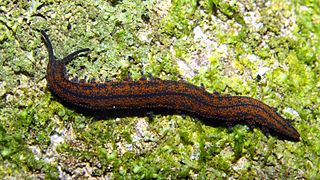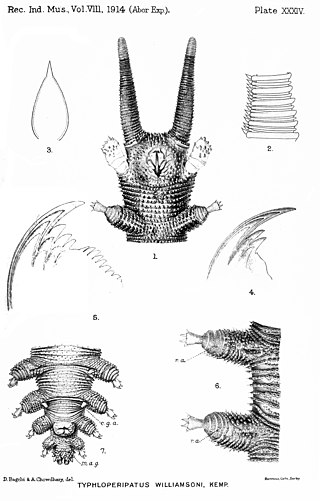
Peripatoides indigo is a velvet worm of the family Peripatopsidae. The Māori name for the velvet worm is ngaokeoke, from the Māori word 'ngaoki', to crawl.

Peripatoides is a genus of velvet worms in the family Peripatopsidae, whose species are found in New Zealand. Like all velvet worms, these animals are nocturnal hunters that spit glue to trap their prey. Species of Peripatoides have 14, 15 or 16 pairs of legs. Female Peripatoides produce eggs that are fertilized internally and babies develop inside their mother until large enough to be born, in batches of 4-6, as colourless miniatures of the parents. These live-bearing Peripatoides have dermal-haemocoelic sperm transfer - which means sperm dissolve holes in the skin of the female to enter the body (haemolymph) anywhere on the body wall of the female.
Plicatoperipatus is a monospecific genus of velvet worm containing the single species Plicatoperipatus jamaicensis. It is endemic to Jamaica. This species ranges from 25 mm to 65 mm in length. Males in this species have 35 pairs of legs; females have 43 pairs, the maximum number found in the phylum Onychophora.

Leucopatus is a genus of velvet worm in the family Peripatopsidae, containing a single species, the blind velvet worm. It is found in northeast Tasmania, Australia, and is ovoviviparous.

Typhloperipatus is a genus of velvet worm in the family Peripatidae, containing the sole species Typhloperipatus williamsoni. It is the only species in the phylum found in South Asia. The species was discovered in northeastern India in 1911.

Occiperipatoides is a monospecific genus of velvet worm containing the single species Occiperipatoides gilesii. This genus is ovoviviparous and found in Western Australia. The genus is part of the ancient phylum Onychophora that contains soft-bodied, many-legged relatives of arthropods known commonly as velvet worms.
Cephalofovea is a genus of velvet worms in the Peripatopsidae family. All species in this genus are ovoviviparous and have 15 pairs of oncopods (legs), and both sexes possess a pitted-head which the male everts and uses to pass his spermatophore to the female. They are found in New South Wales, Australia.

Ooperipatellus is a genus of Australian and New Zealand velvet worms in the Peripatopsidae family. Species in this genus are oviparous. Most species in this genus have 14 pairs of legs, but O. nanus has only 13 pairs, which is the minimum found in the phylum Onychophora. Velvet worms in this genus are among the smallest known, with adults often only 10 to 20 millimeters long. Morphological and molecular data indicate that this genus is a monophyletic group.
Epiperipatus imthurni is a species of velvet worm in the family Peripatidae. The type locality is in Guyana. No males have been recorded from this species. Females have 28 to 32 pairs of legs, usually 30 or 31. Females from Trinidad were shown to reproduce via parthenogenesis; the only velvet worm known to do so.
Epiperipatus barbadensis is a species of velvet worm in the Peripatidae family. Females of this species have 31 pairs of legs. The type locality is in Barbados.
Epiperipatus broadwayi is a species of velvet worm in the Peripatidae family. This species has 29 to 34 pairs of legs. The type locality is in Tobago.
Macroperipatus torquatus is a species of velvet worm in the Peripatidae family. This species has a brown or red back with a bright yellow collar, a black head with black antennae, a white underside with a red tint, and 37 to 42 pairs of legs. This species is found in Trinidad.
Peripatoides kawekaensis is a species of velvet worm in the Peripatopsidae family. This species is ovoviviparous and has 15 pairs of legs. The type locality is in New Zealand's North Island.
Cephalofovea cameroni is a species of ovoviviparous velvet worm in the family Peripatopsidae. This species has 15 pairs of oncopods (legs) and lives in rotting logs and leaf litter. The type locality is Rydal, New South Wales, Australia. Like all members of the genus Cephalofovea, both sexes of C. cameroni have a furrow on the head, between the antennae, which the male everts to carry his spermatophore to the female.
Cephalofovea clandestina is a species of ovoviviparous velvet worm in the family Peripatopsidae. This species has 15 pairs of oncopods (legs) and lives in rotting logs and leaf litter. The type locality is Kanangra-Boyd National Park, New South Wales, Australia. Like all members of the genus Cephalofovea, both sexes of C. clandestina have a furrow on the head, between the antennae, which the male everts to carry his spermatophore to the female.
Cephalofovea pavimenta is a species of velvet worm in the Peripatopsidae family. It is only known from the type locality; Mount Canobolas in New South Wales, Australia.
Cephalofovea tomahmontis is a species of velvet worm in the Peripatopsidae family. This species is ovoviviparous, has 15 pairs of oncopods (legs), and lives in rotting logs and leaf litter. The type locality is Mount Tomah, New South Wales, Australia, after which this species is named. Like all members of the genus Cephalofovea, both sexes of C. tomahmontis have a furrow on the head, between the antennae, which the male everts to carry his spermatophore to the female.
Ooperipatellus insignis is a species of velvet worm in the family Peripatopsidae. Females of this species range from 5 mm to 39 mm in length, while males range from 4 mm to 30 mm in length. This species has 14 pairs of legs and is found in Victoria, Australia.

Ooperipatellus nanus is a species of velvet worm in the family Peripatopsidae. This species is endemic to New Zealand and is found in the South Island.
Peripatopsis sedgwicki is a species of velvet worm in the Peripatopsidae family. This species can have either 20 or 21 pairs of legs, but descriptions usually report 20 pairs of clawed legs. Females of this species range in size from 12 mm to 68 mm in length, whereas males range from 10 mm to 46 mm in length. The type locality is in South Africa.






